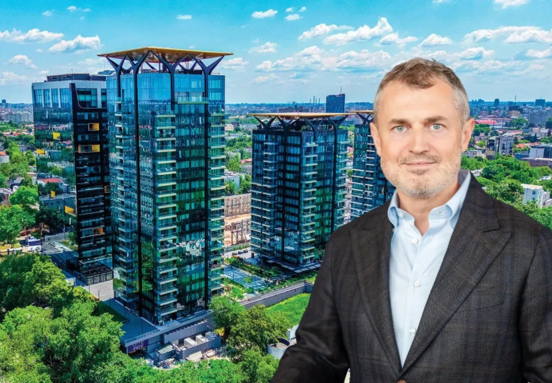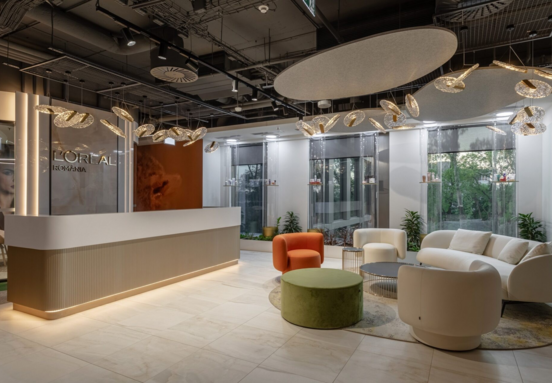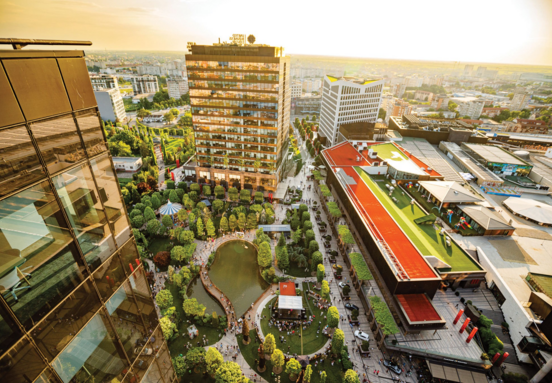Without undermining the severe economic ramifications of the COVID-19 pandemic, which will extend in the medium term, some segments of the Romanian real estate market have surprisingly benefited from the newly emerged context, says the annual report of Crosspoint Real Estate.
Residential sales have peaked, the industrial and logistics market has had a towering success, consumers have resumed their spending behavior along with the softening of restrictions, reducing the pressure felt by the retail segment; even the office market, among the first segments to receive the blow of the impact, has had a reasonable recovery.
As regards the sudden geopolitical crisis, Ilinca Timofte, Head of Research at Crosspoint Real Estate, remarks: “The initial reactions to the effects of the COVID-19 pandemic on the real estate market have been extremely emotional, but after two years we can see not only that most the somber predictions never materialized, but that some sectors have had a surprising evolution during the medical crisis. We could learn from this experience by having a more pragmatic approach to the current geopolitical situation and be more reserved in issuing pessimistic predictions in regards to its effects on the local market. This does not mean, of course, that we should ignore the regional context or that we should expect the Romanian real estate market to remain completely unaffected by it. However, more concrete factors are currently influencing the local market: regardless of the crisis on the northern border, the price of electricity and fuel is high, supply and distribution chains continue to be affected, interest rates will rise substantially to temper the rising inflation. In addition, in Bucharest, the deliveries of new residential projects will be affected in the coming years by the decision of the local authorities to block urban plans, an aspect that will influence both the evolution of new unit prices and the dynamics of the land market and land prices.”
In the following lines, the Crosspoint Real Estate analyst has provided a few highlights regarding the run of the real estate market in the past year and the first three months of 2022, as well as the challenges and opportunities which lay ahead.
Institutional investments in residential assets make an appearance on the Romanian market
The investment activity in 2021 was close to pre-pandemic levels, at 909M EUR, a 13% yoy increase. Even if it still remains the first preference for investors, the office segment has had a significantly smaller share in total investments (43% in 2021 versus 85.3% in 2020 and 62% in 2019). By contrast, investment activity on the industrial market has risen, from a 9% and 10.1% share in total investment volume in 2019 and 2020 respectively, to a 31% share in 2021. A higher investment volume was also recorded on the retail market – 174 M EUR compared to only 27.5 M EUR in 2020.
A series of details in the structure of the investment activity in 2021 point towards the rebound of the market. Firstly, the return of domestic players, whose attitude in 2020 was somewhat reticent. Secondly, regional and secondary markets re-appeared on investors’ radar. Additionally, two significant changes in the Romanian investment landscape have been observed in 2021: the first institutional investment in a single residential product, the acquisition of Braikoff house, a historical building located in Bucharest’s city center, by One United Properties, for 4.9 M EUR; due to an influx of funding, public institutions have entered the investment market. Both of these trends are likely to continue in the following years, as the market conditions for their evolution are extremely favorable. After the first three months of 2022, we may already observe that the public sector’s interest in the acquisition of real assets continues, from the acquisition of the Onix hotel in Cluj-Napoca by Babes-Bolyai University, to IGSU’s intention of buying an office building in Bucharest for its future headquarters.
The optimistic feeling surrounding the real estate market has continued in the first quarter of 2022. The total investment volume has reached 98.6M EUR, a 75% gain compared to Q1 2021. While the enthusiasm at the beginning of the year has been toned down by the sudden geopolitical crisis, the ongoing transactions and overall market feeling seem to point towards a healthy investment activity for the remainder of the year.
Office leasing activity closer to pre-pandemic levels, although office attendance is still low
The evolution of the capital city’s office market in 2021 was characterized by a high number of deliveries (over 240,000 sqm in 10 buildings) which have led to total stock of 3.59 M sqm and a total leasing activity of over 300,000 sqm, 53% higher than the one recorded in 2020.
Developers seem to be pivoting away from some established office hubs like Pipera and the northern area of the city. The new, well-connected Centre-West area expects most of the deliveries in 2022. Simultaneously, the city center’s peerless historical charm has attracted a number of hotel and residential investors in the last couple of years and office developers have followed suit.
Demand was almost equally split between new leases, relocations and renewals in 2021, with expansions making up for only 2% of the total leasing activity. Pre-leases accounted for 14% in total demand. While some sub-leases were recorded on the market, their volume was significantly smaller than anticipated at the beginning of the pandemic, at around 10.000 sqm.
The IT&C sector has kept its position as the main driver of demand for office space, with a share of 31% in total leases. Companies in the energy and industrial sectors and healthcare companies followed IT&C as the top occupiers of the newly leased space in 2021.
The total leasing activity in Q1 2022 amounted 64,863 sqm, a very slight decline compared to the first quarter of 2021, out of which 62% are new leases, followed by renewals (21%). Demand came mainly from the IT&C, professional services, and retail/FMCG sectors.
Four new office projects totaling 72,000 sqm GLA were delivered in Q1 2022 in Bucharest: Tandem, located in city centre, @Expo Phase I in Expozitiei, Sema Oslo&Sema Berlin in Centre-West. Another 63,000 sqm are expected to be delivered by the end of the year.
Although the leasing activity was resumed in 2021, the overall vacancy rate in Bucharest is still at its highest, reaching 12% by the end of the year. Provided that demand for office spaces continues to grow, the vacancy is expected to decrease in 2022. However, presence into the workplace should be taken into account. Many companies have adopted a hybrid way of work in 2021, therefore office attendance remained low, and a prolonged flexible attendance policy might lead to higher vacancy rates in the future. According to Google’s Mobility Report, office attendance in Bucharest in 2021 was on average 38% lower than in the pre-pandemic period.
The demand for industrial spaces more tempered but still strong
Romania’s industrial stock reached 5.8 million sqm at the end of 2021. Over 600,000 sqm of new industrial space have been delivered in 2021, out of which 60% in Bucharest. The market’s steady evolution since 2015 has been accelerated in the context created by the COVID-19 pandemic. The largest players on the market have taken full advantage of the opportunities created under the new circumstances by adopting an assiduous expansion strategy which included both record deliveries as well as acquisition of existing properties. A larger and continuously growing stock but fewer main owners of industrial facilities seems to be the direction in which the Romanian industrial market is currently heading.
The leasing activity amounted to 635,000 sqm, a 14% yoy drop but 39% higher than pre-pandemic levels. Bucharest remains the most dynamic industrial submarket, with a share of 65% in total leasing activity. In a direct proportion to the existing stock, the West and North-West areas of the country have recorded the second highest demand in 2021.
Storage, distribution and logistics were the main activities of new occupiers of industrial space in Romania in 2021, with production facilities making up for only 10% of the demand.
As expected, the disruption of supply chains has been more obvious in 2021 than in the previous year. It was an obstacle which had a ripple effect all throughout the economy and triggered an increase in prices. This has further highlighted the need for locally-based production facilities as well as shorter supply chains.
At 173,000 sqm leased in Q1 2022, the industrial market in Romania continues to move forward, although at a slower pace compared to the same quarter of 2021, when over 223,000 sqm of industrial space were leased. The development of the market is expected to follow the same trend set in the past two years, with demand matching the deliveries and maintaining the low vacancy rates, of 6% in Bucharest and 6.5% on a national level.
Record sales and prices on the residential sector
The unpredicted evolution of the residential market in the first year of the pandemic extended throughout 2021, the first 9 months of the year witnessing an even higher demand than in 2020. Yet, in the last quarter of the year, sales were affected by the soaring inflation rate as well as the reinstatement of some restrictive measures emerged from the rising number of COVID-19 cases. Additionally, the depreciation of the national currency against the Euro (from 4.8371 RON/EUR in 2020 to 4.9204 in 2021) and the growing interest rates have put further pressure on developers and clients alike.
The residential market’s main issue in 2021 was however the rampant increase in the cost of construction materials, of up to 40% compared to 2020. Combined with higher energy prices and the toughening of credit conditions, this led to a steep increase in home prices. In Bucharest, compared to December 2020, the average price/sqm was 17% higher at the end of 2021.
The average price for new units in 2021 reached 1,729€/sqm, while old units averaged 1,567 €/sqm. While both the number of delivered new dwellings and the number of residential permits issued last year were higher than in the previous years, the pressure of the surging construction costs as well as the postponement of urban plans is becoming tangible, an aspect that will become more visible by the end of 2022.
Residential sales have peaked in 2021, following 2020’s trend. On a national level, sales have increased by 56% yoy, while Bucharest and Ilfov have witnessed a 41% boost in sales. Demand has visibly tempered down in October-November, altered by increasing prices and interest rates together with the reinstatement of restrictive measures. The first quarter of 2022 has however recorded a 20% increase in sales compared to the same period of 2021. The sudden change in the geopolitical landscape in February has marked a pause in residential buyers’ appetite, although their interest seems to have partially resumed presently.
The next period will test the endurance of the Bucharest residential market against a number of challenges, such as the ever increasing costs of construction materials, the high interest rates, the depreciation of the RON against the Euro, the postponements of urban zoning plans. While prices are expected to go through an inevitable increase in 2022, it is unlikely that the market will be able sustain a growth rate similar to 2021.
The low availability of inner-city land plots will further increase the prices
The last year has marked a further increase in land prices on a national level and especially in the capital city. Bucharest has a higher GDP per capita than the EU average, which supports a constant demand for office, residential or logistics developers. This consistent growth, together with the decreasing availability of inner-city plots suitable for medium to large scale developments, have created a very dynamic land market.
The number of land transactions in Bucharest and Ilfov was 12% lower than the previous year, yet the largest deals alone amounted to over 350M €. Residential developments were the main destination for the land plots acquired in Bucharest in 2021, with an overwhelming 68% share in total activity.
Due to the increasing scarcity of inner-city plots, the development of surrounding locations in Ilfov county has continued in 2021. The metropolitan areas of the main cities suitable for residential developments are more and more in demand.
2022 will be a year in which inflation is a factor present in everyone’s mind, a situation which is expected to lead to a 10-15% increase in land prices. In addition to this, a trend that is likely to be observed more in Romania in the following years is the fact that the residential market keeps attracting more institutional investors each year. Institutional investments in residential products throughout the EU have reached a 30% share in total investment activity in 2021 and the local market is showing signs that it is mature enough for the residential segment to move into this next stage of development. This aspect will lead to a sustained activity on the land market, a matter highlighted by the fact that the first quarter of 2022 has recorded a 19% yoy increase in land transactions in Bucharest.







